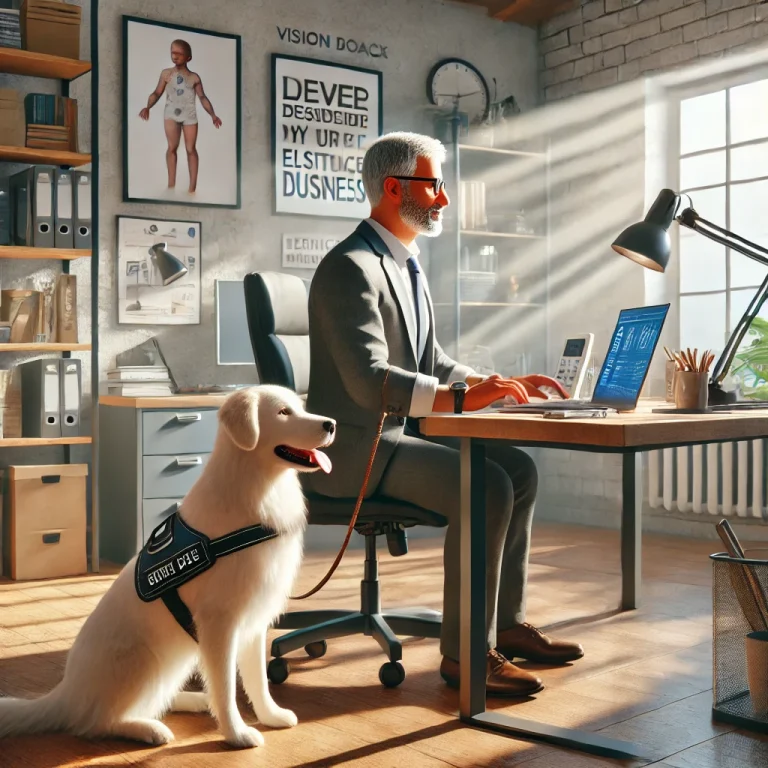Training your service dog for anxiety relief can be a life-changing experience. With the right approach, your service dog can provide you with the support you need to manage your anxiety. In this guide, we’ll cover the essential steps to help you train your service dog effectively. This comprehensive guide will ensure that your service dog becomes an invaluable part of your mental health management strategy.
Why Train Your Service Dog for Anxiety Relief?
Training your service dog for anxiety relief is an empowering journey. A well-trained service dog can help you regain control and improve your mental health. Service dogs offer comfort, provide physical assistance, and can even alert you to oncoming anxiety attacks. This training is not just about teaching commands; it’s about building a bond that enhances your quality of life.
The Importance of a Well-Trained Service Dog
A well-trained service dog is more than a companion; they become your partner in managing anxiety. They provide emotional support, physical comfort, and help you navigate through daily challenges. By learning to respond to your specific needs, a service dog can make a profound difference in your life.
Benefits of Anxiety Relief Training
Anxiety relief training for service dogs includes several benefits, such as:
- Increased Independence: With a trained service dog, you can manage your anxiety more effectively, allowing you to engage in activities and environments that previously felt overwhelming.
- Enhanced Safety: Service dogs can alert you to anxiety attacks, giving you time to take preventive measures and avoid potentially dangerous situations.
- Emotional Support: The presence of a service dog can provide constant companionship, reducing feelings of loneliness and isolation.
- Improved Quality of Life: With the support of a service dog, you can experience a better quality of life, with increased confidence and reduced anxiety symptoms.
Understanding Anxiety Relief Training
Anxiety relief training involves teaching your service dog to recognize signs of anxiety and respond appropriately. This type of training focuses on creating a supportive relationship between you and your dog. It’s essential to use positive reinforcement and consistency to ensure your dog understands and performs the required tasks.
Key Components of Anxiety Relief Training
- Recognition: Your dog needs to learn to recognize your anxiety symptoms, which might include changes in your breathing, posture, or behavior.
- Response: Once your dog recognizes the symptoms, they need to be trained to respond in a way that helps alleviate your anxiety.
- Reinforcement: Positive reinforcement is crucial in training, ensuring your dog associates their actions with rewards.
Choosing the Right Service Dog
Not all dogs are suited for service work. When choosing a service dog for anxiety relief training, consider the following:
- Temperament: Look for a dog that is calm, patient, and eager to please.
- Size: Depending on your needs, the size of the dog may be a factor. Larger dogs are better for tasks like Deep Pressure Therapy.
- Trainability: Some breeds are more trainable than others. Research breeds known for their trainability and temperament.
Getting Started with Anxiety Relief Training
1. Establish Basic Commands
Before diving into anxiety-specific tasks, ensure your dog knows basic commands like sit, stay, and come. These foundational commands are the building blocks for more complex training.
Teaching Basic Commands
- Sit: Hold a treat close to your dog’s nose, move your hand up, allowing their head to follow the treat and causing their bottom to lower. Once in the sitting position, say “Sit” and give the treat.
- Stay: Ask your dog to “Sit.” Open your palm in front of you and say “Stay.” Take a few steps back. If they stay, reward them with a treat.
- Come: Put a leash on your dog. Go down to their level and say “Come,” while gently pulling on the leash. When they get to you, reward them with affection and a treat.
2. Recognize Anxiety Triggers
Identify what triggers your anxiety. This could be certain environments, situations, or even times of the day. Understanding your triggers helps in training your dog to respond to them.
Common Anxiety Triggers
- Crowded Places: Large groups of people can be overwhelming.
- Loud Noises: Sudden, loud sounds can trigger anxiety.
- Stressful Situations: Work, school, or social events can be sources of anxiety.
3. Use Positive Reinforcement
Positive reinforcement is key in service dog training tips. Reward your dog with treats, praise, and affection when they perform a task correctly. This encourages them to repeat the behavior.
Effective Reinforcement Techniques
- Consistent Rewards: Always reward desired behavior to reinforce learning.
- Timing: Give the reward immediately after the desired action.
- Variety: Use different types of rewards (treats, toys, praise) to keep training interesting.
Teaching Anxiety-Specific Tasks
1. Deep Pressure Therapy
Deep Pressure Therapy (DPT) involves your dog applying gentle pressure to your body. This can be incredibly calming during an anxiety attack. Train your dog to lie across your lap or apply pressure with their paws on command.
Training for Deep Pressure Therapy
- Step 1: Begin by inviting your dog to sit with you. Use a command like “Lap” to indicate you want them to lie across your lap.
- Step 2: Gently guide your dog into position, rewarding them when they lie down.
- Step 3: Gradually increase the amount of time they stay in this position, using treats and praise to reinforce.
2. Alerting to Anxiety Attacks
Teach your dog to recognize signs of an impending anxiety attack. This might include changes in your breathing, posture, or behavior. Reward your dog when they alert you to these signs, helping you take preventive measures.
Training for Alerting to Anxiety Attacks
- Step 1: Identify the signs of an anxiety attack that your dog can detect (e.g., increased heart rate, heavy breathing).
- Step 2: Use a specific command (like “Alert”) when you experience these signs, and reward your dog when they respond.
- Step 3: Gradually, your dog will learn to associate these signs with the command and alert you even without the prompt.
3. Fetching Medication or Water
In some cases, having your dog fetch medication or a bottle of water can be very helpful. Use commands like “fetch” and guide your dog to the specific item. Practice regularly to ensure they understand.
Training for Fetching Items
- Step 1: Start with simple fetch commands using a toy. Use the command “Fetch” and reward your dog when they bring the toy back.
- Step 2: Transition to fetching specific items like a medication bottle or water bottle. Place the item in a consistent location.
- Step 3: Practice regularly, rewarding your dog each time they successfully retrieve the item.
Consistency is Key
Training your service dog requires patience and consistency. Regular practice ensures your dog retains and improves their skills. Make training a part of your daily routine.
Maintaining Training Consistency
- Daily Sessions: Incorporate short, daily training sessions to reinforce learning.
- Routine: Establish a consistent routine that your dog can rely on.
- Patience: Be patient and understanding, as training can take time.
Tracking Progress
Keep a training journal to track your dog’s progress. Note improvements and areas that need more work. This will help you stay organized and see how far you’ve come.
Mental Health Support Pets and Their Role
Service dogs are more than just pets; they are mental health support pets. They provide emotional stability and can significantly reduce anxiety symptoms. Investing time in training your service dog enhances their ability to support you effectively.
Emotional Benefits of Service Dogs
- Companionship: Service dogs provide constant companionship, reducing feelings of loneliness.
- Stress Reduction: The presence of a service dog can lower stress levels and provide a calming effect.
- Confidence Boost: With the support of a service dog, individuals often feel more confident and secure.
Service Dogs in Daily Life
Service dogs can assist with various daily activities, from navigating public spaces to providing comfort during stressful situations. Their presence can make challenging environments more manageable.
Importance of Pet Insurance and Service Dog Products
1. Pet Insurance
Pet insurance is crucial for covering unexpected medical expenses. A well-insured service dog is a healthy service dog. Research different pet insurance options to find the best coverage for your furry friend.
Choosing the Right Pet Insurance
- Coverage: Ensure the policy covers accidents, illnesses, and routine care.
- Cost: Compare premiums and deductibles to find an affordable plan.
- Reviews: Read reviews from other pet owners to gauge satisfaction with the provider.
2. Service Dog Products
Invest in high-quality service dog products such as vests, harnesses, and training tools. These products not only aid in training but also ensure your dog is easily identifiable as a service animal.
Essential Service Dog Products
- Vests: A vest clearly identifies your dog as a service animal and can include pockets for carrying items.
- Harnesses: A sturdy harness is essential for guiding and controlling your dog.
- Training Tools: Invest in clickers, treat pouches, and other training aids to facilitate effective training sessions.
Where to Buy
ServicePupSolutions.com offers a range of high-quality service dog products to meet your needs. Visit our site to explore our selection and find the best products for your service dog.
Conclusion
Training your service dog for anxiety relief is a rewarding journey. With dedication and the right approach, your dog can become a reliable support system, helping you manage anxiety and improve your overall well-being.
At ServicePupSolutions.com, we’re committed to providing you with the best resources and products for training your service dog. Remember, with the right training, your service dog can make a significant difference in your life.
Searching for a way to boost your income while keeping your service dog by your side? Click here to start your side hustle and increase your earnings alongside your loyal companion.






